Essay One. Part 1.
Covers the years 1935 to 1956
The Bride of Frankenstein to Tea and Sympathy
This is a two-part essay on Queer Film. Part One is on Queer Film under the notorious Hays Code from 1934-1967. Part two covers the explosion in Queer Films in the ten years (1967-1976) after the demise of the Hays code and its replacement by the MPAA. The essays are not meant to be an in-depth chronicle of Queer Cinema. They reflect the big screen portrayal of the LGBTQ+ community as seen by me, a gay man who, although a medical doctor by profession, fell in love with movies at an early age. A gay man who grew up and went to college and medical school in Ireland and, by chance, got the opportunity to review movies in the mid-nineteen eighties, first for “In Dublin” and then for “The Irish Times.” I have lived in Los Angeles since the mid-nineteen nineties.
What is Queer Cinema? It can mean different things to different people. If there is a gay character that is a character and not a prop for straight people to laugh at, then it’s Queer Cinema. It’s also a sensibility. A sensibility that would bring movies like “The Bride of Frankenstein,” “The Women,” and “Auntie Mame” under the queer umbrella even if they didn’t have gay supporting characters. The fact that gay men directed all these movies completes the picture!
In these essays, I have attached an asterisk to the name of the gay character while the actor’s name playing the gay character is in parenthesis.
If an actor in the movie or someone behind the camera (director, writer, songwriter, production designer) is (was) gay, their names are also listed. If the movie is based on an original idea, novel, or play by a gay writer, that person is also noted.
The first essay spans the period 1934 to 1967: Queer cinema under the notorious Hays Code, which, although formulated in the early twenties, was only enforced, in earnest, with the arrival of Joseph Breen in 1934.
1934 Hays Code

Under Breen, overt references to sexuality, particularly homosexuality, were frowned upon. As a result, gay or straight directors, writers, and actors had to be more creative in presenting while at the same time disguising a gay character.
The 65 Queer Films listed here were all released during the Hays Code era (1934-1967). Fifty-nine were APPROVED as submitted.
“Kind Hearts and Coronets” and “Persona” required cutting before they were released in the US. These cut scenes have now been restored.
“Victim” was released without a stamp of approval. When it was released on VHS in the US in 1986, it received a PG-13 rating.
“Some Like it Hot,” “The Leather Boys,” and “My Hustler” did not seek approval and were released without any consideration for the Hays Office. Billy Wilder’s decision not to submit “Some Like It Hot” signaled the beginning of the end.
As the years have passed and numerous biographies and memoirs have been written, more and more celebrities are now known to have been gay.
- Fred Astaire was probably in a long-term relationship (1933-1969) with his long-time choreographer and doppelganger Hermes Pan.
The other LGBTQ+ Hollywood personalities mentioned in these essays are known to have had same-sex trysts and relationships going back decades. I have a very jaundiced view of the B in LGBTQ+. As far as I am concerned, a man who is sexually attracted to other men is gay or queer. If he also happens to like having sex with women, then good for him. In my view, he is still a gay/queer man who happens to also like having sex with women. The same applies to lesbians in reverse. The terms bisexual and bisexuality are not used in these essays, although the B in LGBTQ+ is allowed to stay!
Here is a short list of such names, which is expanded as each of the 65 movies in this essay – and 45 in the next – are discussed:
- Barbara Stanwyck
- Marlon Brando
- Montgomery Clift
- James Dean
- Walter Pidgeon
- Cary Grant – long-term relationships with actor Randolph Scott and costume designer Orry-Kelly.
- Laurence Olivier – long-term relationship with Danny Kaye
- Anthony Perkins – relationship with fellow actor Tab Hunter in the late fifties. They double-dated some of Hollywood’s most beautiful actresses during this period.
- Husband and wife Vincent Price and Coral Browne.
- Director George Cukor, probably the most famous gay man in Hollywood during this period, was instrumental in fostering two lavender marriages/relationships: Katherine Hepburn and Spencer Tracy and their close friends, the writers Ruth Gordon and Garson Kanin. Hepburn and Tracy cared deeply for one another, but their relationship was a scam set up by their studio, MGM, to squash rumors of their homosexuality. Both couples lived in cottages on the Cukor estate during their time in Hollywood.
- Dirk Bogarde gradually evolved to a more OUT persona as his career developed, although he never officially broached the subject.
- Alec Guinness, Dennis Price, Charles Laughton, and Laurence Harvey were all known to be gay throughout their careers. Their adoring public may have felt there was something. Still, hey, they were English (by way of Lithuania and South Africa in Harvey’s case), so like Olivier, a bit of affectation came with the territory.
- Rock Hudson is the classic Hollywood closet case. Everyone in town knew the story – including the sham marriage – but the public was clueless until a diagnosis of advanced AIDS forced his hand in coming out, with only a few more weeks to live, in the summer of 1985.
Behind the camera were the gay directors James Whale, George Cukor, and Vincente Minnelli, who showed their gay sensibilities to variable degrees and whose careers took divergent routes.
- Minnelli, who was married to gay icon Judy Garland, managed to have a stellar Hollywood career with little to no interference from his studio (MGM). Whale and Cukor, however, suffered for their sexual preference.
- Cukor was fired from “Gone With The Wind” after a few weeks of filming. We will never know the real reason, but no matter how many times Olivia de Havilland vehemently opined against it, the William Haines-Clark Gable rumors and Cukor’s knowledge of what happened between them still have an air of truth today.
- As for Whale, being the most OUT of the great Hollywood directors and being in a well-known relationship with Warner Bros. producer David Lewis didn’t help, especially when tastes changed, and his penchant for high camp lost favor with the public as the thirties progressed.
- The Fifties and Sixties gave us gay directors Nicholas Ray, Tony Richardson, Andy Warhol, and John Schlesinger. Ray directed one of the seminal 1950s (and Los Angeles) movies, “Rebel Without a Cause,” which featured Sal Mineo’s Plato as Hollywood’s first adolescent gay character.
- Meanwhile, Broadway theatre director Morton DaCosta showered his meager (three) Hollywood films with a very gay theatrical style, so much so that his feature debut, “Auntie Mame,” is regarded by many as a camp classic.
- Gay Hollywood power couples existed then, as they do now. Roger Edens and his partner of many years, Leonard Gershe, made the deliciously urbane and witty Audrey Hepburn-Fred Astaire vehicle, “Funny Face.”
- Famous gay stage designer Oliver Messel was Oscar-nominated for one of his few forays into Film, “Suddenly Last Summer.”
- The source material during this period came from a rich collection of gay playwrights and novelists: Tennessee Williams and William Inge, Patricia Highsmith, Oscar Wilde, Patrick Dennis, and Herman Melville.
- Of the 65 movies listed in essay one (parts 1/2), 16 are based on original screenplays, and 49 are adapted from another medium.
During the Hays Code years, there were two branches of filmmaking where being gay, if not an advantage, was undoubtedly the norm.
- Costume Design: It may surprise you that the allure of the Costume Department to the gay sensibility applies to both sexes. Edith Head and Irene Scharaff, Hollywood’s greatest female costume designers, were gay. As for the men, well, you can just run through the list: Gilbert Adrian, Milo Anderson, Travis Banton, Bill Blass, Howard Greer, Charles Le Maire, Jean Louis, Moss Mabry, Anthony Mendleson (in London), Bernard Newman, Orry-Kelly, Walter Plunkett, Howard Shoup, Bill Thomas, William Travilla, Arlington Valles and many, many more. Some were in lavender marriages, but all expressed their gayness in their on-screen work.
- CHOREOGRAPHY: While Fred Astaire and his longtime companion Hermes Pan choreographed the unforgettable dance sequences in “Top Hat” (1935), Fred’s career was bookended by the stunning work of another gay choreographer, Eugene Loring in “Funny Face” (1957). Meanwhile, gay choreographer Jack Cole’s contribution to the musical numbers “Put The Blame on Mame” and “Amado Mio” from “Gilda” and “Diamonds are a Girl’s Best Friend” from “Gentlemen Prefer Blonds” is the essential ingredient in making these movies immortal.
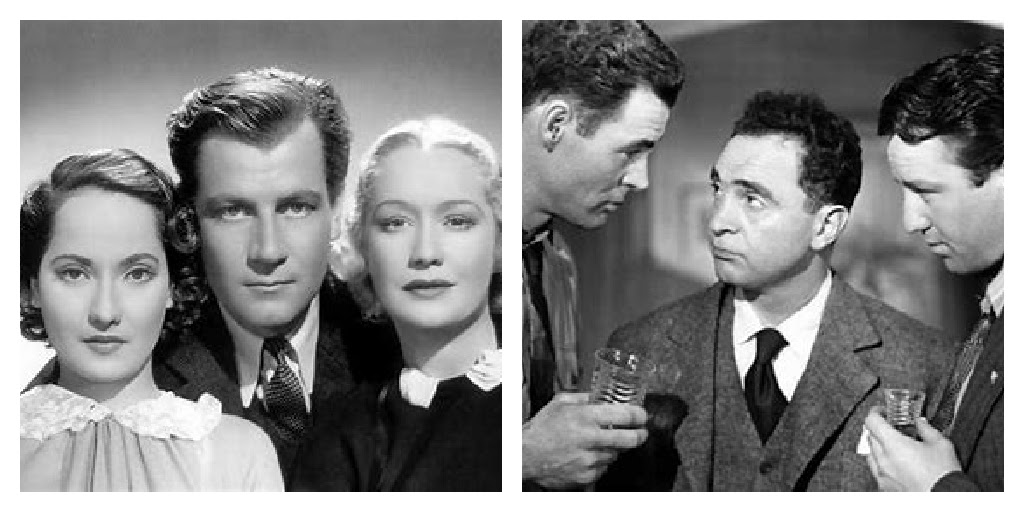
Finally, there are two movies that were based on Queer material, but because of the times in which they made their respective debuts – 1934 on Broadway for Lillian Hellman’s play “The Children’s Hour” and 1945 for Richard Brooks’s novel “The Brick Foxhole” – American movie screens were not ready to hear the words homosexual, gay, queer or lesbian. As a result, “The Children’s Hour” was reworked by Hellman herself into a heterosexual triangle. Directed by William Wyler under the title “These Three” for Samuel Goldwyn, it was a major success. Wyler later reworked the material using Hellman’s original storyline in 1961 to lesser effect. With a screenplay by John Paxton, “The Brick Foxhole” was made into the 1947 Oscar-nominated movie “Crossfire” by director Edward Dmytryk; it featured a great cast that included Robert Young, Robert Mitchum, Robert Ryan, and Sam Levene. The book’s homophobia, however, was replaced by anti-semitism, the country’s ability to sympathize with certain minority groups only extending so far in the late nineteen forties.
My major influences in writing these essays are the following:
- The Celluloid Closet: Homosexuality in the Movies: Vito Russo’s landmark 1981 non-fiction book.
- Queer & Now & Then: Michael Koresky’s series of articles on Queer Cinema in the Magazine Film Comment.
- Homosexuality in Film Noir: Richard Dyer’s seminal 1977 article on Homosexuality in Film Noir in the Magazine JUMP CUT
- I Lost It at the Movies (1965), Kiss Kiss Bang Bang (1968) and When the Lights Go Down (1980): Three essential collections of film criticism by my favorite film critic, Pauline Kael.
THREE OF THE MOVIES LISTED WON BEST PICTURE, WHILE FIVE MORE WERE NOMINATED IN THIS CATEGORY
1. The Bride of Frankenstein (1935)
A-
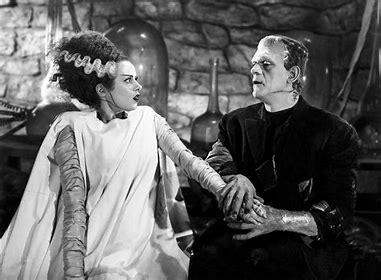
James Whale
(APPROVED)
LGBTQ+ CHARACTER
*Dr. Pretorius (Ernest Thesiger)
LGBTQ+ DIRECTOR | ACTOR
DIRECTOR: James Whale
ACTOR: Ernest Thesiger
Susan Sontag: Notes on Camp: 1964: The Partisan Review
You thought it (camp) meant a swishy little boy with peroxided hair, dressed in a picture hat and a feather boa, pretending to be Marlene Dietrich? Yes, in queer circles they call that camping. … You can call [it] Low Camp…
Susan Sontag: The Partisan Review 1964
High Camp is the whole emotional basis for ballet, for example, and of course of baroque art … High Camp always has an underlying seriousness. You can’t camp about something you don’t take seriously. You’re not making fun of it, you’re making fun out of it. You’re expressing what’s basically serious to you in terms of fun and artifice and elegance. Baroque art is basically camp about religion. The ballet is camp about love …
Susan Sontag: The Partisan Review 1964
Director James Whale’s masterpiece is as close to Susan Sontag’s definition of high camp as the movies can deliver. Meanwhile, Elsa Lanchester’s star is born in the title role, sporting the most creative “do” in cinema history. Gay actor Ernest Thesiger, whose portrait was sketched by no less than John Singer Sargent in 1911, gives his most famous performance as Dr. Frankenstein’s gay mentor, Dr. Pretorious.
The premise was suggested by “Frankenstein,” the 1818 novel by Mary Wollencraft Shelley.
NOW STREAMING ON AMAZON PRIME VIDEO, APPLE TV+, YOUTUBE
2. Top Hat (1935)
A+
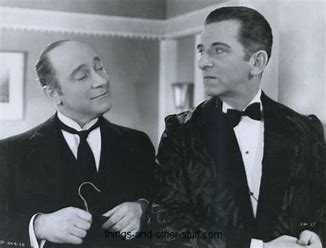
Mark Sandrich
(APPROVED)
LGBTQ+ CHARACTERS
*Horace Hardwick (Edward Everett Horton)
*Bates (Eric Blore)
LGBTQ+ ACTORS | CHOREOGRAPHER | COSTUME DESIGNER
ACTOR: Fred Astaire
ACTOR: Eric Blore
ACTOR: Edward Everett Horton
ACTOR: Erik Rhodes
CHOREOGRAPHER: Hermes Pan
COSTUME DESIGNER: Bernard Newman
More plural personalities
HORACE HARDWICK (EDWARD EVERETT HORTON) ON FIRST MEETING BATES (ERiC BLORE) in “TOP HAT”
The Best of the Astaire-Rogers movies.
Of the nine films Astaire and Rogers made at RKO Pictures in the thirties, “Top Hat” is their best. It’s also their most indubitably gay, with Eric Blore doing his butler with a superior attitude and Edward Everett Horton, whose own unique variation on the double take (an actor’s reaction to something, followed by a delayed, more extreme reaction) had yet to become tiresome.
Irving Berlin’s songs are some of his best, and the dance to “Cheek to Cheek,” choreographed by Astaire and his longtime collaborator and alleged lover at the time, Hermes Pan, is Astaire-Rogers at their peak.
Gay actor Erik Rhodes, who had also appeared in “The Gay Divorcee” the previous year, makes an indelible impression as Alberto Beddini, a dandified Italian fashion designer with a penchant for malapropisms. Rhodes spent most of his life on Broadway; the rest of his Hollywood output was mainly forgettable.
The film’s production design (by Carroll Clark, with Van Nest Polglase being the head of the design department) marked the peak of the Art Deco movement in Hollywood.
Original screenplay by Allan Scott and Dwight Taylor from a story by Taylor. Cinematography by David Abel.
SONGS BY IRVING BERLIN
- No Strings (I’m Fancy-Free)
- Isn’t This a Lovely Day (to be Caught in the Rain)
- Top Hat, White Tie and Tails
- Cheek to Cheek
- The Piccolino
ASTAIRE-ROGERS AT RKO
- Flying Down to Rio (1933)
- The Gay Divorcee (1934)
- Roberta (1935)
- Top Hat (1935)
- Follow the Fleet (1936)
- Swing Time (1936)
- Shall We Dance (1937)
- Carefree (1938)
- The Story of Vernon and Irene Castle (1939)
NOW STREAMING ON AMAZON PRIME VIDEO, APPLE TV+, YOUTUBE
3 Sylvia Scarlett (1935)
B-
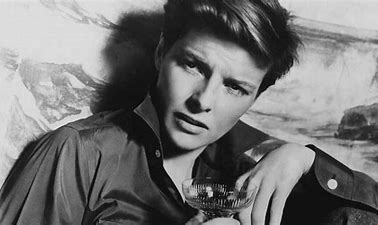
George Cukor
(APPROVED)
LGBTQ+ CHARACTER
*Sylvia/Sylvester Scarlett (Katherine Hepburn)
LGBTQ+ DIRECTOR | ACTORS | COSTUME DESIGNER
DIRECTOR: George Cukor
ACTOR: Cary Grant
ACTRESS: Katherine Hepburn
COSTUME DESIGNER: Bernard Newman
Hepburn plays a female con artist who dresses as a boy to avoid the police. With gay and trans themes, Hepburn’s turn as Sylvia/Sylvester Scarlett set the bar impossibly high for actors brave enough to consider working in Queer Cinema for years to come. Unfortunately, the movie is not very good, and Cukor’s direction seems off. It was one of the great financial disasters of the 1930s, and it almost brought RKO to its knees. Because of this movie and “Bringing Up Baby,” exhibitors labeled Hepburn box office poison. It marked the first of four Hepburn/Grant pairings. The complete list is as follows:
- Sylvia Scarlett (1935, George Cukor)
- Bringing Up Baby (1938, Howard Hawks)
- Holiday (1938, George Cukor)
- The Philadelphia Story (1940, George Cukor)
There is a gradual improvement, with each movie being better than the previous one. This progression culminates in the triumph that is “The Philadelphia Story,” Cukor’s masterpiece, and Hepburn’s (and Grant’s—with “Notorious” and “North By Northwest”) greatest performance.
Adapted from the novel by Compton MacKenzie.
NOW STREAMING ON AMAZON PRIME VIDEO AND ON APPLE TV+
4. Bringing Up Baby (1938)
A-
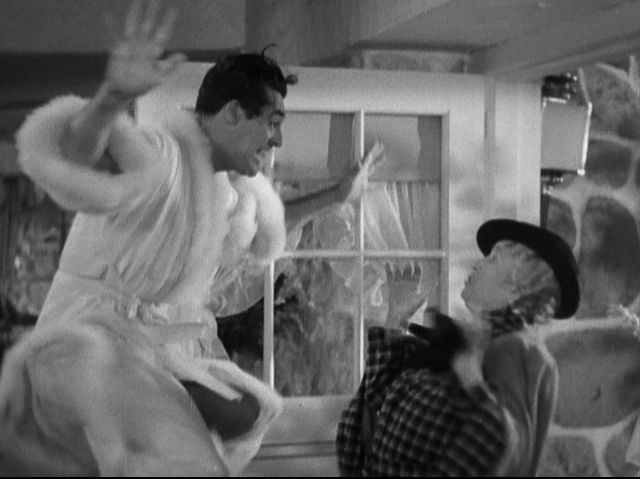
Howard Hawks
(APPROVED)
LGBTQ+ CHARACTER
*David Huxley (Cary Grant) goes gay all of a sudden when he answers the front door dressed in a négligée.
LGBTQ+ ACTORS | COSTUME DESIGNER
ACTOR: Cary Grant
ACTRESS: Katherine Hepburn
COSTUME DESIGNER: Howard Greer
Because I just went gay all of a sudden
DAVID HUXLEY (CARY GRANT) in “BRINGING UP BABY “
In Howard Hawks’s “Bringing Up Baby,” Cary Grant answers the front door dressed in a négligée because Katherine Hepburn has hidden all his clothes. When Hepburn’s aunt, played by May Robson, asks him to explain, he replies exasperatedly, “Because I just went gay all of a sudden” (and leaping into the air at the word gay). There are no further references to Grant’s character being Gay/Queer/homosexual in the rest of the movie. How often was gay used as a synonym in the vernacular for homosexuality in 1938? Can I get a linguist? Can I get a linguist? Grant plays a paleontologist who gets involved in several predicaments involving a scatterbrained heiress (Hepburn) and a leopard named Baby. The film represents the peak of Hollywood’s slapstick era, with Grant taking a couple of classic tumbles.
Dudley Nichols and Hagar Wilde adapted it from a short story by Wilde, which originally appeared in Collier’s Weekly magazine on April 10, 1937.
REMADE AS “WHAT’S UP DOC” BY PETER BOGDANOVICH IN 1972.
NOW STREAMING ON AMAZON PRIME VIDEO, ON APPLE TV+, youtube
5. The Women (1939)
A-
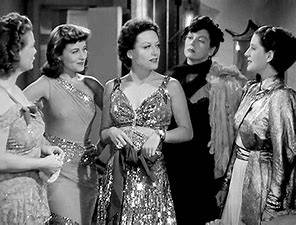
George Cukor
(APPROVED)
LGBTQ+ CHARACTER
*Nancy Blake (Florence Nash)
LGBTQ+ DIRECTOR | ACTORS |COSTUME DESIGNER
DIRECTOR: George Cukor
ACTRESS: Marjorie Main
COSTUME DESIGNER: Gilbert Adrian
“The Women” has the distinction of being the first American film with an all-female cast. All the art featured in the movie was by women. The screenplay was by two women (Anita Loos and Jane Murfin) based on a play written by a woman (“The Women” by Claire Booth Luce from 1936). All the animals featured were female. Unfortunately, this being 1939, everyone behind the camera was male, albeit with Hollywood’s most outstanding gay director, George Cukor, at the helm just one month after being fired from “Gone with the Wind” for, by some accounts, being too gay! The only apparent lesbian, an “old maid” who always wears slacks – no, it’s not Katherine Hepburn – is played by Florence Nash.
NOW STREAMING ON AMAZON PRIME, APPLE TV+, YOUTUBE
6. The Wizard of Oz (1939)
A-

Victor Fleming
(APPROVED)
LGBTQ+ CHARACTER
*Cowardly Lion (Bert Lahr)
LGBTQ+ COSTUME DESIGNER
Gilbert Adrian
Judy Garland/Dorothy: She is the mother of all of us! Before there was Barbra, before there was Liza, before there was Madonna, before there was Lady Gaga, there was Judy.
How and why gay men came to refer to themselves as “Friends of Dorothy,” I don’t know. Judy Garland was not gay, but there was something glorious about her performance in “The Wizard of Oz,” which captured most people’s hearts, gay or straight. Something vulnerable yet confident. And there’s that incredible voice at once innocent and knowing. She gets to sing the greatest movie song ever written, “Over the Rainbow,” thanks to the genius of Harold Arlen (music) and Yip Harburg (lyrics). Photographed in glorious Technicolor by Harold Rosson (bookended by black and white for Kansas) and directed by Victor Fleming, the man who took over “Gone with the Wind” after George Cukor was fired. Queer Cinema can be a small world. Oh, of course, Bert Lahr’s Cowardly Lion was gay. Almost forgot!
Adapted from the novel by L. Frank Baum.
NOW STREAMING ON AMAZON PRIME VIDEO, APPLE TV+, MAX (YOUTUBE)
7. Rebecca (1940)
A+
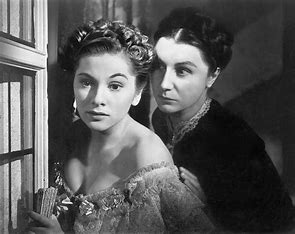
Alfred Hitchcock
(APPROVED)
LGBTQ+ CHARACTER
*Mrs. Danvers (Judith Anderson)
LGBTQ+ ACTORS
ACTOR: Laurence Olivier
ACTRESS: Judith Anderson
REBECCA IS ONE OF HITCHCOCK’S SEVEN PERFECT FILMS.
Hitchcock LIKED to cast gay actors in LGBTQ ROLES.
Judith Anderson as Mrs. Danvers IN REBECCA, ANTHONY PERKINS IN PSYCHO and Farley Granger AND JOHN DAHL IN ROPE
While working for Mrs.Van Hopper (Florence Bates) in Monte Carlo, a young woman (Joan Fontaine) becomes acquainted with Maxim de Winter (Laurence Olivier), a recent widower. After a brief courtship, they become engaged. They marry and then head to his mansion in England, Manderly. Mrs. Danvers (Judith Anderson), the head housekeeper at Manderly, is obsessed with the memory of Maxim’s first wife, Rebecca, who died under mysterious circumstances, and she despises the new Mrs. de Winter, whom she belittles at every opportunity. “Rebecca” marked the arrival in Hollywood (courtesy of “Gone with the Wind,” producer David O. Selznick) of the man who was, or would eventually become, the greatest director in the history of cinema. Superb performance by Joan Fontaine, who showed that she was every bit as talented as her sister, the great Olivia de Havilland.
Music by Franz Waxman. Oscar-winning cinematography by George Barnes. Excellent work by George Sanders, Reginald Denny, and Gladys Cooper.
Adapted from the novel by Daphne du Maurier.
Hitchcock’s cameo: 2:06:57 He is the man in a bowler hat and trenchcoat who crosses paths with George Sanders.
NOW AVAILABLE FOR STREAMING ON YOUTUBE (Cine Moi)
8. The Maltese Falcon (1941)
A-
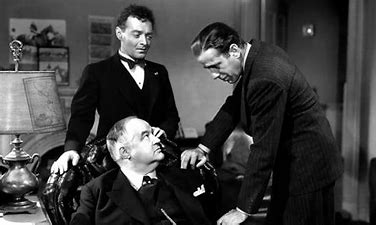
John Huston
(APPROVED)
LGBTQ+ CHARACTER
*Joel Cairo (Peter Lorre)
*Kasper Gutman (Sydney Greenstreet)
*Wilmer Cook (Elisha Cook Jr)
LGBTQ+ COSTUME DESIGNER
Orry-Kelly
After several years as a screenwriter, John Huston made a smashing directorial debut with his adaptation of Dashiell Hammett’s 1930 novel. It had been adapted once before in 1931 as a pre-code starring Ricardo Cortez and Bebe Daniels. However, Huston’s remake is now considered the definitive version. Humphrey Bogart got his big break playing Sam Spade, a San Francisco private detective dealing with three unscrupulous adventurers (Mary Astor, Sydney Greenstreet, and Peter Lore), all seeking a jewel-encrusted falcon statuette. Everyone knows that Peter Lorre’s character, Joel Cairo, is gay. Even Sam knows. Sam will only slap Joel, never giving him the dignity of a punch. Wilmer (Elisha Cook Jr.) is referred to as “Wilmer the gunzel,” gunzel being an old English term for “kept boy” or homosexual. Since he is Kasper Gutman’s kept boy, I can only assume that Sydney Greenstreet’s Kasper is also gay. Splendid, dear boy!
Bogart would remain a star until he died in 1957. One of the quintessential film noirs, “Falcon” has not stood the test of time as well as some of its contemporaries, probably because of a plot that does not make much sense. However, the performances are there to savor, with the great Ms. Astor doing a superb turn as Bridget O’Shaughnessy. Meanwhile, the gay triumvirate of Peter Lorre, Sydney Greenstreet, and Elisha Cook Jr. bring up the rear!
Outstanding cinematography by Arthur Edeson.
NOW STREAMING ON AMAZON PRIME VIDEO, APPLE TV+, YOUTUBE
9. The Man Who Came to Dinner (1942)
A-
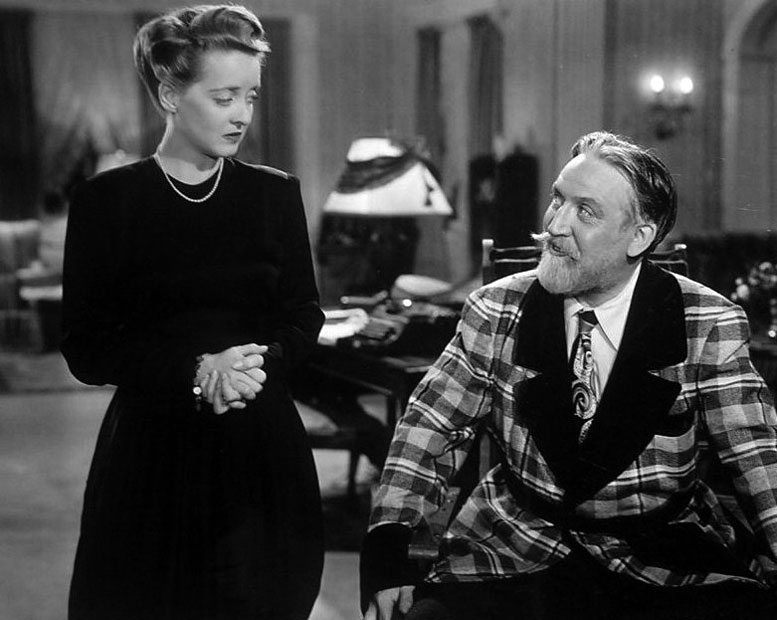
William Keighley
(APPROVED)
LGBTQ+ CHARACTER
*Sheridan Whiteside (Monty Wooley)
LGBTQ+ ACTOR | SOURCE MATERIAL | COSTUME DESIGNER
ACTOR: Monty Wooley
SOURCE MATERIAL: Alexander Woollcott (The character of Whiteside is modeled on the famously acerbic gay theatre critic)
COSTUME DESIGNER: Orry-Kelly
I am not only walking out on this case, Mr. Whiteside, I am leaving the nursing profession. I became a nurse because all my life, ever since I was a little girl, I was filled with the idea of serving a suffering humanity. After one month with you, Mr. Whiteside, I am going to work in a munitions factory. From now on, anything I can do to help exterminate the human race will fill me with the greatest of pleasure. If Florence Nightingale had ever nursed YOU, Mr. Whiteside, she would have married Jack the Ripper instead of founding the Red Cross! (sic)
Nurse Preen (Mary Wickes) in “THE MAN WHO CAME TO DINNER”
Monty Wooley delights himself and his audience by playing the impossibly pompous Sheridan Whiteside in William Keighley’s excellent 1941 adaptation of George Kauffman/Moss Hart’s play “The Man Who Came to Dinner.”
While passing through small-town Ohio during a cross-country lecture tour, Whiteside breaks his hip after slipping and falling on the icy steps of the house of the Stanleys, a prominent Ohio family with whom he’s supposed to dine as a publicity stunt. He insists on recuperating in their home during the Christmas holidays.
The character of Whiteside is based on the playwrights’ good friend, the acerbic gay theatre critic Alexander Woollcott. Bette Davis is perfection playing Whiteside’s long-suffering yet understanding secretary. It’s one of her few comedic roles, making you wonder why she didn’t do more.
The excellent supporting cast includes Ann Sheridan, nicely parodying herself, Richard Travis as Miss Davis’ love interest, the irrepressible Jimmy Durante singing “Did You Ever Have the Feeling That You Wanted to Go, And Still Have the Feeling That You Wanted to Stay?,” Mary Wickes as Nurse Preen who has the unenviable task of nursing Whiteside back to health, Reginald Gardiner doing a parody of Noel Coward and Billie Burke and Grant Mitchell as the unfortunate Mr. and Mrs. Stanley.
Monty Wooley, Clifton Webb, and Cole Porter were at the nexus of New York’s gay scene during the Roaring Twenties.
NOW STREAMING ON AMAZON PRIME VIDEO, APPLE TV+, YOUTUBE
10. Casablanca (1942-1943)
A+
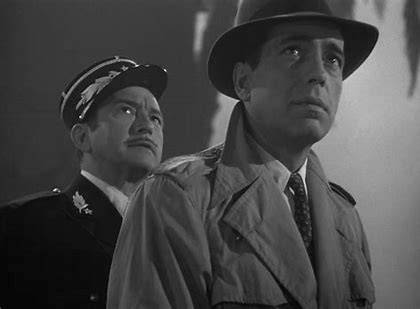
Michael Curtiz
(APPROVED)
LGBTQ+ CHARACTERS IN ONE OF MANY POSSIBLE FUTURES:
*Rick Blaine (Humphrey Bogart)
*Captain Louis Renault (Claude Rains)
I think this is the beginning of a beautiful friendship
HUMPHREY BOGART TO CLAUDE RAINS IN “CASABLANCA”
After Ilsa (Ingrid Bergman) and Victor (Paul Henreid) are safely away on their plane to America and Major Strasser (Conrad Veidt) is dead, Rick (Humphrey Bogart) and Captain Renault (Claude Rains) walk away together into the mist as Rick recites one of the movie’s most famous lines to Louis. For a moment, it is possible to feel that Rick and Louis are really in love, and one of their possible futures is a long and happy life together.
The film takes place in Casablanca, Morocco, with most of the action happening at a tavern called Rick’s, named for the hero of the story, played by Bogart. The plot begins when an old flame, Ilsa Lund (Bergman), suddenly appears with her husband, Victor Laslow (Henreid), who’s wanted by the Nazis. Rick has to decide whether to put aside his feelings for Ilsa to help Victor escape to help the Resistance. With Dooley Wilson as Sam, the piano player.
Herman Hupfeld’s song “As Time Goes By” was used to great effect in the movie, and the song’s melody was incorporated into Max Steiner’s famous score and used as a leitmotif throughout the film. However, the song was not written for the movie. It was originally written for the Broadway show “Everybody’s Welcome” in 1931. Arthur Edesen did the gorgeous cinematography.
Written on the fly by the fabulous Epstein twins (Philip and Julius) together with Howard Koch and directed by Michael Curtiz with what can only be described as the hand of God, Casablanca is one of the most romantic and enjoyable of all the great Hollywood movies. In addition to our lead quote, here are some other mouthwatering examples of the screenwriters’ craft:
Play it once, Sam. For old times’ sake
ILSA (INGRID BERGMAN) TO SAM (DOOLEY WILSON) in “CASABLANCA”
Of all the gin joints in all the towns in all the world, she walks into mine
RICK (HUMPHREY BOGART) TO SAM (DOOLEY WILSON) in “CASABLANCA”
Here’s looking at you, kid
RICK (HUMPHREY BOGART) TO ILSA (INGRID BERGMAN) in “CASABLANCA”
I’m shocked to find out that gambling is going on!
Renault (CLAUDE RAINS) TO RICK (HUMPHREY BOGART) IN “CASABLANCA”
The problems of three little people don’t amount to a hill of beans in this crazy world
RICK (HUMPHREY BOGART) TO ILSA (INGRID BERGMAN) in “CASABLANCA”
We’ll always have Paris.
RICK (HUMPHREY BOGART) TO ILSA (INGRID BERGMAN) in “CASABLANCA”
Round up the usual suspects
RENAULT (CLAUDE RAINS) TO RICK (HUMPHREY BOGART) in “CASABLANCA”
“Casablanca” had its world premiere on November 26, 1942, in New York City to coincide with the Allied invasion of North Africa and was released in Los Angeles and nationally on January 23, 1943, to coincide with the Churchill-Roosevelt Casablanca conference. Hence, according to the AMPAS rules at the time, the film was eligible for the 1943 Academy Awards even though it was released in New York in 1942. At the 16th Academy Awards held at Grauman’s Chinese Theatre on Thursday, March 2, 1944, it won Best Film (Hal B. Wallis producer), Best Director (Curtiz) and Best Adapted Screenplay (the Epstein brothers and Koch). It was Jack Warner’s run to the podium to accept the award that deeply upset Wallis, who promptly resigned from Warner Bros. and formed his own production under the Paramount banner.
Adapted from the play “Everybody Comes to Rick’s by Murray Burnett and Joan Alison.
NOW STREAMING ON AMAZON PRIME VIDEO, APPLE TV+, Max (YOUTUBE)
11. Laura (1944)
A+
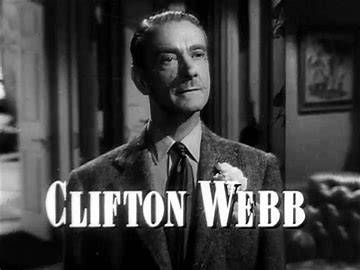
Otto Preminger
(APPROVED)
LGBTQ+ CHARACTER
*Waldo Lydecker (Clifton Webb)
LGBTQ+ ACTORS
ACTOR: Clifton Webb
ACTOR: Vincent Price
ACTRESS: Judith Anderson
LIKE MOST OF THE GREAT FILM NOIRS FROM THE FORTIES, THE FILM BEGINS WITH A NARRATOR, AND THE NARRATIVE UNFOLDS IN FLASHBACK
“I shall never forget the weekend Laura died. A silver sun burned through the sky like a huge magnifying glass. It was the hottest Sunday in my recollection. I felt as if I were the only human being left in New York. For with Laura’s horrible death, I was alone. I, Waldo Lydecker, was the only one who really knew her. And I had just begun to write Laura’s story when – another of those detectives came to see me. I had him wait. I could watch him through the half-open door. I noted that his attention was fixed upon my clock. There was only one other in existence, and that was in Laura’s apartment in the very room where she was murdered“
Clifton Webb as Waldo Lydecker in “Laura.”
Detective Mark McPherson (Dana Andrews) is investigating the murder of a young, beautiful advertising executive, Laura Hunt (a magnificent Gene Tierney in a star-making performance) killed by a shotgun blast to the face just inside the doorway of her apartment. He first interviews newspaper columnist Waldo Lydecker (Clifton Webb, becoming a Hollywood star at fifty), an imperious, effete (read homosexual) older man who has become Laura’s mentor. McPherson also questions Laura’s parasitic playboy fiancé, Shelby Carpenter (Vincent Price), a “kept man” tethered to her wealthy socialite aunt (Judith Anderson) Ann Treadwell. One night, the detective falls asleep in Laura’s apartment in front of her portrait. He is awakened by a woman entering with her own key and is shocked that it is Laura. She finds a dress in her closet that belonged to one of her models, Diane Redfern. McPherson concludes that the body assumed to have been Laura was Redfern, drawn there for a liaison by the unfaithful Carpenter while Laura was away in the country. With Laura still alive, unmasking the killer becomes even more urgent.
One of the reasons for firing “Laura’s” original director, Rouben Mamoulian, was his attitude towards Webb. His less-than-stellar treatment of the seasoned theatrical actor on the set because of his sexual orientation has become the stuff of Hollywood lore. However, a more likely reason for his dismissal was the direction he was taking the material. Remember, Mamoulian is more famous for the films he didn’t make (was fired from) than those he did – in addition to “Laura,” he was also fired from the sets of “Oklahoma” and “Cleopatra.” The head of Twentieth Century Fox, Darryl Zanuck, then handed the film over to producer Otto Preminger. It was a stroke of sheer genius that will never be forgotten.
Adapted from Vera Caspary’s novel by Samuel Hoffenstein, Elizabeth Reinhardt and an uncredited Ring Lardner Jr. The Oscar-winning cinematography is by Joseph LaShelle (trumping John Seitz’s equally stunning work on “Double Indemnity”), and the haunting score -one of the all-time greats – is by David Raksin.
REMADE AS SHARKY’S MACHINE BY BURT REYNOLDS IN 1981
NOW STREAMING ON AMAZON PRIME VIDEO, APPLE TV+, YOUTUBE
12. Double Indemnity (1944)
A+
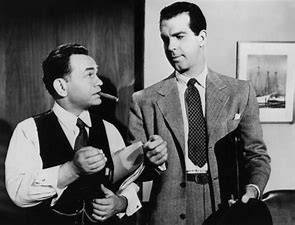
Billy Wilder
(APPROVED)
LGBTQ+ CHARACTERS
*Walter Neff (Fred MacMurray)
*Barton Keyes (Edward G. Robinson)
LGBTQ+ ACTOR | COSTUME DESIGNER
ACTRESS: Barbara Stanwyck
COSTUME DESIGNER: Edith Head
WERE THEY QUEER FOR EACH OTHER?
MY FAVORITE FILM NOIR OF THE FORTIES.
THE FIRST FILM TO CAPTURE THE SIGHTS AND SOUNDS OF LOS ANGELES.
LIKE MOST OF THE GREAT FILM NOIRS FROM THE FORTIES, THE FILM BEGINS WITH A NARRATOR, AND THE NARRATIVE UNFOLDS IN FLASHBACK
Walter Neff, a successful insurance salesman for Pacific All-Risk Insurance, returns to his office building in downtown Los Angeles late one night. Clearly in pain, he sits at his desk and tells the whole story into a Dictaphone for his colleague Barton Keyes, a claims adjuster.
The greatest of the film noirs that Hollywood churned out from the mid-forties into the fifties, this 1944 crime thriller was directed by Billy Wilder, co-written by Wilder and Raymond Chandler, and produced by Buddy DeSylva. The screenplay was based on James M. Cain’s 1943 novel of the same title, which appeared as an eight-part serial for Liberty magazine in February 1936.
The film stars Fred MacMurray as an insurance salesman, Walter Neff, and Barbara Stanwyck as Phyllis Dietrichson, the black widow spider who traps him in a plot to kill her husband and then claim the insurance money. Edward. G. Robinson also stars as MacMurray’s boss, Barton Keyes, a claims adjuster whose job is to find phony claims. “Double Indemnity” refers to a clause in particular life insurance policies that doubles the payout when the death is accidental.
All three stars are superb, with Stanwyck and Robinson giving Oscar-worthy performances. At least Stanwyck was nominated, but she unjustly lost out to Ingrid Bergman in “Gaslight.” In contrast, neither MacMurray nor Robinson got any love from their peers. Robinson’s absence from the Best Supporting Actor lineup that year is arguably, the most egregious snub in Oscar history.
Wilder has stated in various interviews that he believes the real love affair was between Walter (MacMurray) and Keyes (Robinson). You can feel their deep attachment all the way through the movie to their beautiful and moving final scene together. The dynamic between Neff and Dietrichson (Stanwyck) seems more about power than genuine emotion. There is no love there.
The film is also redolent of Los Angeles, it being the first Hollywood movie to go out and capture the sights and sounds of the city’s varied locales:
- The Dietrichson House in Glendale (actually in the Beachwood Canyon area) is where Walter first meets Phyllis (and her ankle bracelet) for the first time.
- The Market in Los Feliz, where Walter and Phyllis have clandestine meetings.
- Walters’s apartment on Melrose Avenue.
- The corner of Franklin and Vermont, where Walter drops off Lola (Jean Heather), Phyllis’ step-daughter who suspects that her mother is up to no good.
- Walter and Lola lying on the grass behind the Hollywood Bowl as a concert shimmers in the distance.
- Downtown Los Angeles, where the Pacific All-Risk insurance offices are located.
The magnificent score is by Miklos Rozsa. The cinematography is by John F. Seitz, who photographed Wilder’s Oscar-winning “The Lost Weekend” and “Sunset Boulevard.”
REMADE AS BODY HEAT BY LAWRENCE KASDAN IN 1981
NOW STREAMING ON AMAZON PRIME VIDEO, APPLE TV+, YOUTUBE
13. Murder My Sweet (1944)
B+
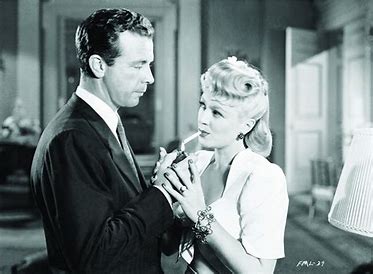
Edward Dmytryk
(APPROVED)
LGBTQ+ CHARACTER
*Lindsay Marriott (Douglas Walton)
HE SMELLS REAL NICE!
(Elevator Boy about Marriott)
YOU’D BETTER PUT YOU FLAPS DOWN OR YOU’LL TAKE OFF
(Marlow to Marriott)
I’M NOT IN THE HABIT OF GIVING PEOPLE GROUNDS FOR BLACKMAIL, MR. MARLOWE
(Marriott)
“Murder, My Sweet” was released under its original book title of “Farewell My Lovely” in the United Kingdom but was retitled to a less mellifluous moniker for its United States release. It was the first film to feature author Raymond Chandler’s primary character, the hard-boiled private detective Philip Marlowe and here, I think, is a good time to dig a little deeper and list those actors who have played Marlowe down through the years:
1944
DICK POWELL
“MURDER MY SWEET/FAREWELL MY LOVELY”
1946
HUMPHREY BOGART
“THE BIG SLEEP”
1947
ROBERT MONTGOMERY
“LADY IN THE LAKE”
1969
JAMES GARNER
“MARLOWE”
1973
ELLIOTT GOULD
“THE LONG GOODBYE”
1975
ROBERT MITCHUM
“FAREWELL MY LOVELY”
Powell is in very good company, and he acquits himself admirably. He also gets props for being the first to play Marlowe and for making a successful transition from Warner Bros. crooner to hard-boiled private dick. It must not have been easy, especially since director Edward Dmytryk’s and screenwriter John Paxton’s plot lines become as confusing as Howard Hawks’s narrative twists in “The Big Sleep.” But while the supporting cast is fine – Esther Role, Anne Shirley, Claire Trevor, Otto Kruger, Miles Mander and the marvelous Mike Mazurki – there is nothing here to compare with Humphrey Bogarts’s bookstore dalliance with Dorothy Malone in Hawk’s masterpiece. Which brings us to our LGBTQ+ character. His name is Lindsay Marriott, and he is played by character actor Douglas Walton. He only has two scenes before he is horribly dispatched in true Queer fashion. We even sense his Queerness before we set eyes on him – the elevator boy, who has let him up, in advance, to Marlowe’s office, thinks, “He Smells Nice.” And, finally, there he is, mincing around the office in his fabulous overcoat and ascot tie, as nervous as Bette Davis without a cigarette. And despite his protestations, he is clearly being blackmailed to make a money-for-jewels exchange. How sad!
Dmytryk and the film’s producer, Adrian Scott, were members of the Hollywood Ten and spent time in jail for being members of the Communist Party and taking the First Amendment. Blacklisted from working in Hollywood, Dmytryk changed his mind and named names – including that of film director Jules Dassin – and his career recovered. But at what cost? Scott did not name names and moved to England like many in his situation. Anne Shirley, who married Scott and retired from acting following this film, sent him a Dear John Letter asking for a divorce, which she obtained in 1948 after four years of marriage. She lived the rest of her life in Los Angeles.
NOW STREAMING ON AMAZON PRIME VIDEO, APPLE TV+, YOUTUBE
14. The Uninvited (1944)
B-
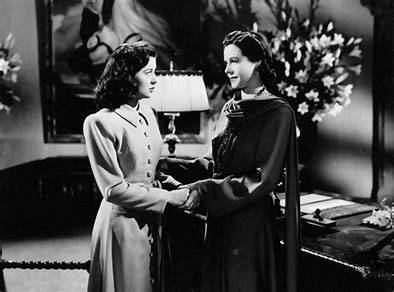
Lewis Allen
(APPROVED)
LGBTQ+ CHARACTERS
*Pamela Fitzgerald (Ruth Hussey)
*The Ghost of Mary Meredith (Lynda Grey, uncredited)
*Stella Meredith (Gail Russell)
*Miss Holloway (Cornelia Otis Skinner)
The Ghost of Carmel (Betty Farrington, voice only, uncredited) – no spoilers!
LGBTQ+ ACTOR | COSTUME DESIGNER
ACTRESS: Cornelia Otis Skinner
COSTUME DESIGNER: Edith Head
A Queer Ghost Story with so many lesbian characters that it’s challenging to keep count! It’s either FOUR (three living and one dead) or FIVE (three living and two dead). “The Uninvited” was a big hit back in 1944 and still entertains. The film opens with lesbian number one, Pamela Fitzgerald, played by Ruth Hussey. Pamela and her brother Rick (Ray Miland, then at the peak of his Hollywood stardom) fall in love with an old house on the Cornwall coast of England. The way director Lewis Allen introduces his film, you initially think they are newlyweds, which is quite naughty of him. It’s only after you notice Huussey’s very boyish “do” that you know this cannot be the case! Heavens! Our brother and sister combo discover a room with a chill – it’s a few degrees cooler than the rest of their dream house. Turns out the ghost of lesbian number two haunts it. That would be Mary Meredith. Mary, like Hitchcock’s Rebecca four years earlier, died under mysterious circumstances by falling off a nearby cliff, and it seems that she wants her daughter Stella (Gail Russell, looking beautiful before the effects of her alcoholism began to show) to die in the same way. However, the communication between mother and daughter feels more erotic than maternal, and Stella likes it! Good grief, it’s lesbian number three. It also transpires that Mary, before she passed to the other side of the Sapphic divide, had a female lover, leading us to lesbian number four, Miss Holloway, played by gay writer and actress Cornelia Otis Skinner. Now, this is where things get complicated. It turns out that there is a second, seemingly more benevolent ghost named Carmel, the former mistress of Stella’s father. Carmel is also very interested in Stella. Is she lesbian number five? Or are her concerns more maternal than Mary’s? Well, there will be no spoilers here!
The movie gives you the occasional shiver, and it’s fun to see how Hussey and Skinner interpret their Queer characters – Hussey taking the comedic approach and Skinner giving us a variation on Judith Anderson’s Mrs. Danvers. Today, what dazzles are Charles Lang’s immaculate, Oscar-nominated, black-and-white cinematography and Victor Young’s haunting theme for Stella, which was later made into a song with lyrics by Ned Washington entitled “Stella by Starlight.” The costumes are by gay costume designer Edith Head.
The film was so popular that director Allen and star Russell went on to make another horror movie/ghost story called “The Unseen,” also at Paramount, which was another monster hit that was released the following year.
Now, as to the sexual preferences of Ray Milland’s Rick. Well, he is a music critic……………. Hmmmm!
Adapted by Dodie Smith and Frank Partos from the novel ” by Dorothy Macardle, “Uneasy Freehold.”
“The Uninvited ” is unavailable for streaming. However, the DVD can be purchased at Amazon.
15. The Picture of Dorian Gray (1945)
A

Albert Lewin
(APPROVED)
LGBTQ+ CHARACTERS
*Dorian Gray (Hurd Hatfield)
*Basil Hallward (Lowell Gilmore)
LGBTQ+ ACTORS | COSTUME DESIGNER
ACTOR: Hurd Hatfield
ACTOR: Lowell Gilmore
COSTUME DESIGNER: Arlington Valles
Having worked as Irving Thalberg’s closest assistant – and winning an Oscar for producing “Mutiny on the Bounty” – for most of the Thirties at MGM, Albert Lewin became a producer at Paramount after “The Boy Wonder” passed away at age 37 in 1936. Always a man with great literary aspirations, he went one step further and became a writer/director, debuting with a mediocre adaption of Somerset Maugham’s “The Moon and Sixpence.” However, back at MGM, he directed his masterpiece, a superb adaptation of Oscar Wilde’s “The Picture of Dorian Gray” with an impossibly beautiful Hurd Hatfield as Dorian – the fact that his performance was subtle to the point of understatement has always seemed suitable to me. He’s like Tyrone Power with a permanent facial mask.
Beautifully handled by Lewin, it is one of MGM’s best movies of the Forties, boasting superb production design and gorgeous black and white cinematography by Oscar winner Harry Stradling – breaking into color for the climactic closeup of Ivan Le Lorraine Albright’s infamous painting now at the Art Institute of Chicago. The superb cast includes George Sanders as Lord Henry Wotton, Wild’s heterosexual stand-in, scattering his bon mots like rose petals at a wedding, Angela Lansbury getting her second Oscar nomination in two years as Sybil Vane, the young girl that Dorian destroys, which seals his fate, Richard Fraser as her vengeful brother and Peter Lawford and Donna Reed both looking impossibly fresh and youthful. Finally, there is Dorian’s best friend, Basil Hallward. He is played by gay actor Lowell Gilmore, who, like Hatfield, deserved much better from Hollywood.
NOW STREAMING ON AMAZON PRIME VIDEO, APPLE TV+, YOUTUBE
16. Gilda (1946)
A-
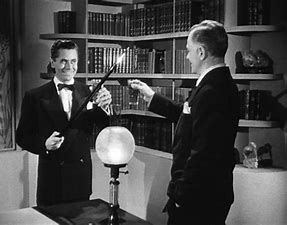
Charles Vidor
(APPROVED)
LGBTQ+ CHARACTERS
*Johnny Farrell (Glenn Ford)
*Ballin Mundson (George Macready)
LGBTQ+ CHOREOGRAPHER AND COSTUME DESIGNER
CHOREOGRAPHER: Jack Cole
COSTUME DESIGNER: Jean Louis
WERE THEY QUEER FOR EACH?
Feast your eyes on Charles Vidor’s stylish direction, Rudolph Mate’s lush black-and-white cinematography (unusual for a noir film), the Jean Louis gowns, and, of course, Rita Hayworth as Gilda, one of Hollywood’s most iconic heroines.
Although Glenn Ford and George Macready always insisted that they believed their characters were gay, Vidor disagreed. The plot and the characters’ motivations are hopelessly convoluted, so “Gilda” is a problematic film to grade on the Queer spectrum. However, it’s Queer enough to have two of the greatest song numbers in the history of Cinema: “Put the Blame on Mame” and “Amado Mio” “sung” in grand style by Hayworth (dubbed by Anita Ellis) and stunningly choreographed by The Father of Theatrical Jazz Dance, Jack Cole. Doris Fisher and Allan Roberts wrote both of the classic songs.
Original screenplay by Jo Eisinger, Marion Parsonnet, and Ben Hecht (uncredited) from a story by E.A. Ellington.
NOW STREAMING ON AMAZON PRIME VIDEO, APPLE TV+, YOUTUBE
17. Brute Force (1947)
B+
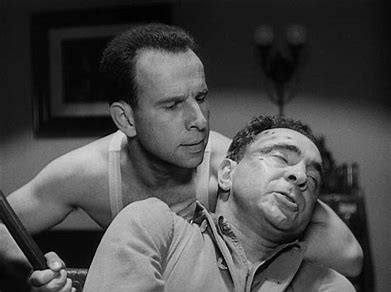
Jules Dassin
(APPROVED)
LGBTQ+ CHARACTERS
*Captain Munsey (Hume Cronyn)
“Brute Force” was among several noir films made by director Jules Dassin during the postwar period. The others were “Thieves’ Highway,” “The Naked City,” and “Night and the City.” The latter is that rare film noir which is set in London. Britain had its own glorious period of film noir thanks to the genius of Carol Reid and “The Odd Man Out,” “The Fallen Idol” and “The Third Man” in addition to John Boulting’s “Brighton Rock” and J. Lee Thompson’s “Yield to the Night.” However, none of them made London City a character in the movie like Dassin did in “Night and the City.” He had gone to London because of rumors that he was going to be investigated by HUAC. Shortly after his return to the US, he was named by a recanting Edward Dmytryk, and his Hollywood career was over.
It’s an expertly told prison break story with an above-average screenplay by future director Richard Brooks. Our LGBTQ+ character is the hateful Captain Munsey, a sadist who speaks in a slightly higher octave than the rest of the male cast and the prison’s lone female warden. Munsey is fastidious about his looks – there is a beautiful and lovingly choreographed shaving sequence – and he is interested in art and music. There is no doubt about it. He is a raving homosexual and a very nasty one at that! Hume Cronyn, a consummate actor, plays him to the hilt. Cronyn has played a number of gay parts on stage and screen and he also helped gay writer Arthur Laurents adapt “Rope” for Hitchcock; his performance is never insulting. In fact, we are constantly on the edge of our seats in case he orders another unfortunate inmate to his office for another round of torture. But Cronyn is not the only actor who you cannot take your eyes off. A superb Burt Lancaster, who had just become a star in Producer Mark Hellinger’s “The Killers,” is back in Hellinger territory as Joe Collins, a prisoner who cannot take the Munsey treatment and is planning a breakout. His fellow prisoners consist of such greats as Charles Bickford, Sam Levene, Jeff Corey, Whit Bissell, and Art Smith, who, as the prison’s alcoholic doctor, gets to break the fourth wall and make an appeal to the audience as the closing credits begin to roll.
NOW STREAMING ON AMAZON PRIME VIDEO, APPLE TV+, MAX (YOUTUBE)
18. Red River (1948)
A-
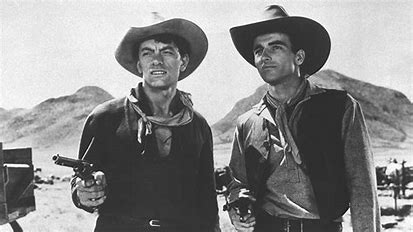
Howard Hawks
(APPROVED)
LGBTQ+ CHARACTERS
*Matt Garth (Montgomery Clift)
*Cherry Valance (John Ireland)
LGBTQ+ ACTOR
Montgomery Clift
In one of the greatest Westerns ever made, director Howard Hawks takes us along the infamous Chisholm Trail, and the first cattle drive from Texas to Kansas. In one of his most emblematic roles, John Wayne is Thomas Dunson, the rancher who initiates the affair, while Montgomery Clift is Garth, his adopted adult son. Of course, they clash at every opportunity in the excellent script by Borden Chase and Charles Schnee. The year was 1948, and Clift was breaking out all over. In “Red River,” he more than held his own in his dramatic confrontations with Wayne. Meanwhile, he was equally impressive as the American soldier in Fred Zinnemann’s “The Search” and the unfortunate gentleman caller in William Wyler’s “The Heiress.”
“River” was his film debut, and it’s kudos all the way, particularly when you realize that he was diving in at the deep end by doing some major flirting with John Ireland’s gunslinger Cheery Valance. The two become inseparable, and, in one classic scene, Valance asks to see Garth’s gun. They compare sizes and have a shootout! It’s one of the incredible gay moments on film.
Also, with Walter Brennan, Noah Beery Jr., Joanne Dru, and Coleen Gray – Both Dru and Gray are superb, and “Red River” impresses as one of the few Westerns with not just one but two very memorable female characters. The stunning cinematography (black and white) is by Hawks’ favorite cameraman Russell Harlan. The rousing score is by Dimitri Tiomkin.
Adapted from the 1946 story “The Chisholm Trail” in The Saturday Evening Post by Borden Chase.
NOW STREAMING ON AMAZON PRIME VIDEO, APPLE TV+, YOUTUBE
19. Rope (1948)
A-
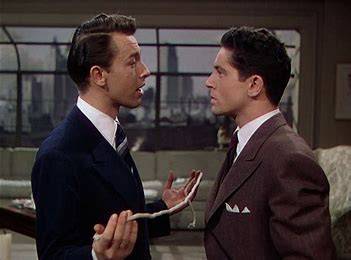
Alfred Hitchcock
(APPROVED)
Filmed in 8 x 10-minute takes.
LGBTQ+ CHARACTERS
*Rupert Cadell (James Stewart)
*Brandon Shaw (John Dall)
* Phillip Morgan (Farley Granger)
LGBTQ+ ACTORS | SCREENWRITER | COSTUME DESIGNER
ACTOR: John Dall
ACTOR: Farley Granger
SCREENWRITER: Arthur Laurents
COSTUME DESIGNER: Gilbert Adrian
THE FIRST GAY (MALE) COUPLE TO DECEIVE THE HAYS OFFICE
HITCHCOCK’S FIRST FILM IN COLOR
Hitchcock LIKED to cast gay actors in LGBTQ ROLES.
Hitchcock’s famous experiment could have evolved over coffee with Eisenstein. The two great directors, having mastered the language of cinema many times over, now know that it is a marriage of two separate yet complementary entities:
1) Mise-en-scene: the production design, costume design, camera position and movement, actors’ positions, and movement within a scene.
2) editing, or what you fashion from your mise-en-scene to make your movie.
But Hitchcock wants to know what a movie would be like if you eliminated editing and only had mise-en-scene. Would it be like a filmed play, taken by someone in the audience with a movie camera? There was a problem, however, in that each film’s roll only lasted 10 minutes. Hitchcock overcame this by backing the camera up to an inanimate object, such as furniture, and quickly changing the film.
Adapted from Patrick Hamilton’s play by actor/writer Hume Cronyn with a screenplay by gay writer Arthur Laurents, the story is based on the famous Leopold & Loeb case from the early twenties. Granger and Dall are perfect as Phillip Morgan and Brandon Shaw, the two young aesthetes (read homosexual couple) who strangle to death their former classmate from prep school in their Manhattan penthouse apartment. They commit the crime as an intellectual exercise: they want to prove their superiority by committing the “perfect murder.” After hiding the body in a large antique wooden chest, Brandon and Phillip host a dinner party – using the chest as a buffet table for the food – at the apartment, which has a panoramic view of Manhattan’s skyline. The guests, who are unaware of what has happened, include the victim’s father, Mr. Kentley (Sir Cedric Hardwicke) and aunt (Constance Collier). Brandon and Phillip’s idea for the murder was inspired years earlier by conversations with their prep-school housemaster, publisher Rupert Cadell (Jimmy Stewart, who is also excellent). While they were at school, Rupert had discussed with them, in an apparently approving way, the intellectual concepts of Nietzche’s “Superman” as a means of showing one’s superiority over others. He, too, is among the guests at the party since Brandon, in particular, thinks that he would approve of their “work of art.” It is also intimated that Cadell is the boys’ former lover.
The end result is an astonishing achievement and one of Hitchcock’s best films. Yet, despite the film’s overall excellence, you are aware that Hitch is disabled by having half of the silver screen’s vernacular off limits. It’s like he’s working with only the right (spatial) side of his brain.
Hitchcock’s cameos: “Rope” is one of FIVE Hitchcock films in which he makes not one but TWO cameo appearances. The others are “The Lodger” (1927), “Suspicion” (1941), “Under Capricorn” (1949), and “Strangers on a Train” (1951).
Cameo one: 0:01:51: Just after Hitchcock’s credit towards the end of the opening sequence, walking alongside a woman.
Cameo two: 0:55:00: Through the window, we see a red flashing neon sign of his trademark profile
NOW STREAMING ON AMAZON PRIME VIDEO, APPLE TV+, YOUTUBE
20. Kind Hearts and Coronets (1949)
A+

Robert Hamer
Approved After Major Revisions, later restored
LGBTQ+ CHARACTER
*Lady Agatha D’Ascoyne (Alec Guinness)
LGBTQ+ DIRECTOR | ACTORS | SCREENWRITER | COSTUME DESIGNER
DIRECTOR: Robert Hamer
ACTOR: Alec Guinness
ACTOR: Dennis Price
SCREENWRITER: Robert Hamer
COSTUME DESIGNER: Anthony Mendleson
MY FAVORITE BRITISH MOVIE
Kind Hearts and Coronets (1949) is the most delicious concoction ever produced by Michael Balcon and Michael Relph’s Ealing Studios, and it is my favorite British film. Robert Hamer’s exquisitely intelligent and stylish direction, based on a screenplay he wrote with John Dighton (“The Man in the White Suit” and “Roman Holiday”), flows like dark chocolate over a mouthwatering sundae.
Starring the deliciously urbane Dennis Price as lowly draper’s assistant Louis Mazzini, who finds himself distantly in line for a dukedom. Infuriated by this aristocratic family’s cruel treatment of his mother – she eloped with his father, who was a lowly musician – he becomes a serial killer, setting out to systematically murder all eight of the Ascoyne-D’Ascoynes ahead of him in line for the seat of D’Ascoyne-Chalfont.
Alec Guinness has fun playing all nine D’Ascoynes – in a short flashback involving the elopement of Louis’ father and mother, we catch a glimpse of him as a ninth D’Ascoyne, the 7th Duke of Chalfont, Etheired’s father. That’s three generations and both sexes, with the older generations offering a delicious tongue-in-cheek glimpse into the professions favored by the male members of the British upper classes in the Edwardian era. By the time Louis finds himself in the employ of the Banker, Lord Ascoyne D’Ascoyne, the first of Louis’ casualties, Young Ascoyne D’Ascoyne, has already died in a boating accident. The names of Louis’s other victims and their method of dispatch are as follows:
Ethelred D’Ascoyne, 8th Duke of Chalfont (hunting accident)
The Reverend Lord Henry D’Ascoyne (poisoned)
The General, Lord Rufus D’Ascoyne (bomb)
The Admiral, Lord Horatio D’Ascoyne. (Goes down with his ship)
Louis’s employer and the final victim is the banker, Lord Ascoyne D’Ascoyne. He dies of shock on learning that he is the last D’Ascoyne standing.
Lady Agatha D’Ascoyne, Ethelred’s sister, is a militant suffragette whom Louis shoots down from her hot air balloon while she is distributing leaflets over London. Since this is part one of a two-part essay on Queer Film, we must assume that Lady Agatha is most assuredly gay. Price, Guinness, and Hamer were all homosexuals, making this a very gay affair, indeed.
The younger generation consists of the philandering Young Ascoyne D’Ascoyne, whose arrogance causes Louis to get fired from his original draper’s assistant position and whose drowning sets Louis’ killing spree in motion. Then, the one good egg in the basket, Young Henry D’Ascoyne, is married to the beautiful Edith. His passion for amateur photography allows Louis to switch some chemicals in his darkroom, leading to death by explosion.
However, Price is the star of “Kind Hearts and Coronets,” helped immeasurably by his two magnificent leading ladies. The plum-voiced Joan Greenwood dazzles as that little minx Sybella, her every utterance at once an aphrodisiac and a condemnation. And the aristocratic Valerie Hobson was never better than as the pure-at-heart Edith D’Ascoyne, widow of Young Henry D’Ascoyne, and the person on whom Louis sets his sights to marry. Miles Matheson has a few hilarious moments as “The Hangman.”
It was adapted from Roy Horniman’s 1907 novel Israel Rank: The Autobiography of a Criminal. The novel’s strong anti-Semitic sentiment had to be removed.
Douglas Slocombe’s stunning black-and-white cinematography marked a visual peak for Ealing.
POINTS OF INTEREST
Both Robert Hamer and Dennis Price suffered from alcoholism, and both of their careers peaked with this movie.
Valerie Hobson found herself in a life-imitating art scenario when she stood by her husband, the disgraced politician John Profumo, during the scandal of 1963.
Leeds Castle in Kent was used for Chalfont, the family home.
The film’s title comes from the antepenultimate stanza of the poem “Lady Clara Vere de Vere” by Lord Alfred Tennyson, published in 1842: “However it be / it seems to me, / ’Tis only noble to be good. / Kind hearts are more than coronets, / And simple faith than Norman blood,”
NOW STREAMING ON AMAZON PRIME VIDEO, APPLE TV+, YOUTUBE
21. Adam’s Rib (1949)
A
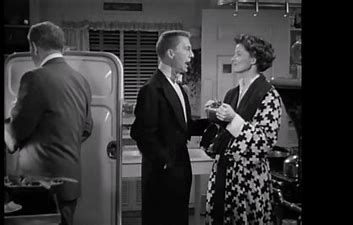
George Cukor
(APPROVED)
LGBTQ+ CHARACTER
*Kip Lurie (David Wayne)
LGBTQ+ DIRECTOR | ACTORS |SCREENWRITERS | COSTUME DESIGNER
DIRECTOR: George Cukor
ACTOR: Spencer Tracy
ACTRESS: Katherine Hepburn
ACTRESS: Hope Emerson
SCREENWRITER: Ruth Gordon
SCREENWRITER: Garson Kanin
COSTUME DESIGNER: Walter Plunkett
MY FAVORITE TRACY-HEPBURN MOVIE
Screenwriters Ruth Gordon and husband Garson Kanin populated their court case Tracy/Hepburn (Adam/Amanda) comedy with a bunch of great supporting characters played by the likes of Judy Holliday, Jean Hagen, Hope Emerson, Tom Ewell and, as Amanda’s “gay best friend,” David Wayne’s Kip Lurie. Kip is their next-door neighbor and a Broadway composer.
Gay with his closely cropped hair (so fashionable today!) and flamboyant behavior, he is the constant butt of Adam’s putdowns, such that it wouldn’t be hard to turn Kip into a woman since he is halfway there already. Kip, nevertheless, pursues Amanda with dogged determination, to the point of composing a song especially for and about her entitled “Farewell Amanda” (written by Cole Porter, no less). Thanks to Wayne’s inspired performance, Kip is one of Hollywood’s most memorable gay characters from the Hays code era.
Oscar-nominated original screenplay by Ruth Gordan and Garson Kanin.
NOW STREAMING ON AMAZON PRIME VIDEO, APPLE TV+, YOUTUBE
22. All About Eve (1950)
A+
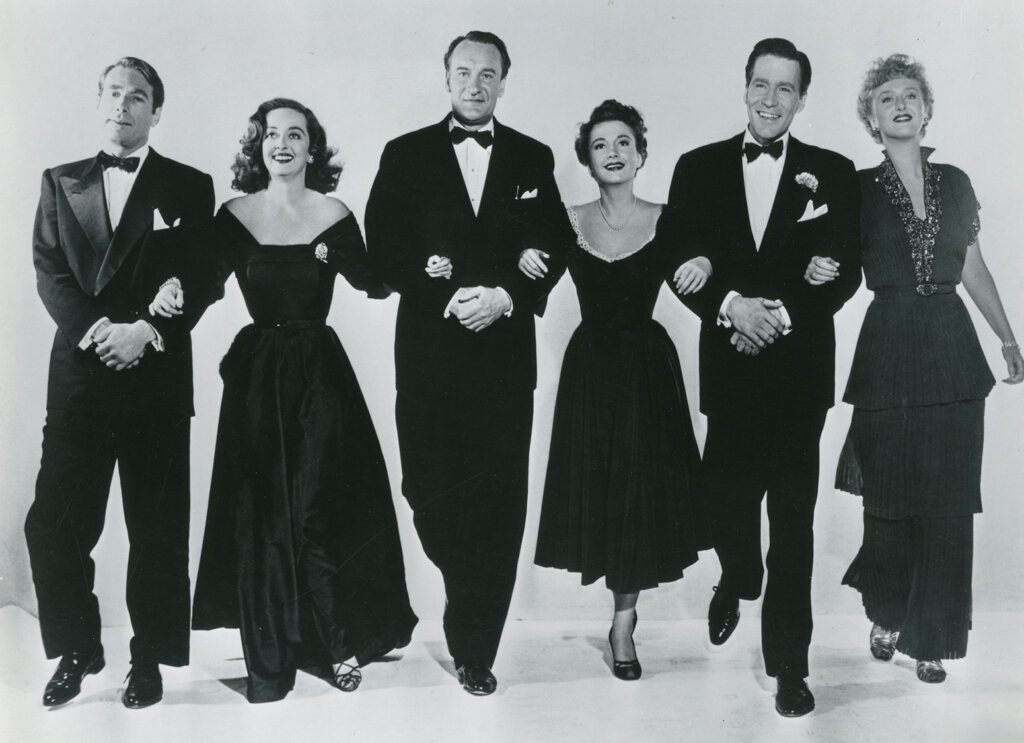
Joseph L. Mankiewicz
(APPROVED)
LGBTQ+ CHARACTERS
*Eve Harrington (Anne Baxter)
*Addison DeWitt (George Saunders)
LGBTQ+ COSTUME DESIGNERS
COSTUME DESIGNER: Edith Head
COSTUME DESIGNER: Charles LeMaire
EVERYONE’S FAVORITE BETTE DAVIS MOVIE
Anne Baxter plays the scheming understudy Eve Harrington, while George Sanders plays the influential drama critic Addison DeWitt. Both Eve and Addison are gay, and Addison blackmails Eve, letting her know how much they have in common:
That I should want you at all suddenly strikes me as the height of improbability, but that, in itself, is probably the reason. You’re an improbable person, Eve, and so am I. We have that in common. Also, a contempt for humanity, an inability to love and be loved, insatiable ambition – and talent. We deserve each other…and you realize, and you agree how completely you belong to me?
Addison DeWitt (George Sanders) to Eve Harrington (Anne Baxter) in “All About Eve”.
Director Joseph L. Mankiewicz’s masterpiece is based on one of the greatest screenplays ever written (by Mankiewicz from Mary Orr’s short story “The Wisdom of Eve”). It highlights the greatest, most cherished, most quoted, and most imitated performance of all time by Hollywood’s most outstanding actress, Bette Davis, as Margo Channing.
With one of the greatest casts ever assembled for a motion picture: Left to Right pictured above: Gary Merrill, Bette Davis, George Sanders, Anne Baxter, Hugh Marlowe, and Celeste Holm. Also Featured were Thelma Ritter (getting the first of her six best supporting actress nominations), Gregory Ratoff, Barbara Bates, and, making quite an impression in her second major part (after “The Asphalt Jungle” over at MGM), Marilyn Monroe.
NOW STREAMING ON AMAZON PRIME VIDEO, APPLE TV+, YOUTUBE
23. Caged (1950) C-
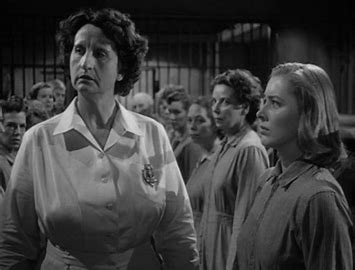
John Cromwell
(APPROVED)
LGBTQ+ CHARACTERS
*Evelyn Harper, the sadistic matron (Hope Emerson)
*Kitty Stark, the murderous shoplifter (Betty Garde)
*Ruth Benton, the reformist prison superintendent (Agnes Moorhead)
LGBTQ+ ACTORS
ACTRESS: Hope Emerson
ACTRESS: Agnes Moorehead
“Hype the New Fish”
Betty Garde, on seeing Eleanor Parker for the first time
Hollywood’s first female prison movie with an innocent Eleanor Parker (Marie) up against all those old prison dykes! Oscar nominations for Parker and Hope Emerson as the sadistic warden. As you would expect, it has not dated well but can be enjoyed as camp, particularly the performances of Emerson and Betty Garde as the inmate who gives Marie the advice she needs to survive on the inside.
Original screenplay by Virginia Kellogg and Bernard C. Schoenfeld from a story by Kellogg and Schoenfeld.
NOW STREAMING ON AMAZON PRIME VIDEO, APPLE TV+, YOUTUBE
24. Young Man with a Horn (1950)
B
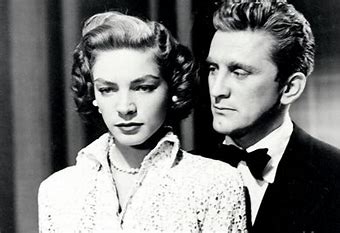
Michael Curtiz
(APPROVED)
LGBTQ+ CHARACTER
*Amy North (Lauren Bacall)
*Miss Carson (Katherine Kurasch, uncredited)
LGBTQ+ COSTUME DESIGNER
Milo Anderson
A LESBIAN COUPLE OUTWITS THE HAYS OFFICE
Like “Mildred Pierce, “this is another Michael Curtiz movie that works equally well as drama and camp. Lauren Bacall is Kirk – a young man with a horn – Douglas’ society wife, who is also a closeted lesbian. But not for long! One evening, she brings home a beautiful and sophisticated date, Miss Carson (Katherine Kurasch, uncredited). Miss Carson is an artist, and Betty has been checking out her collection! Also, when Bacall makes the introduction, “This is my husband, Miss Carson, I told you about her,” the placement of the three actors in the scene and the inflection in Bacall’s voice makes it seem that it is Miss Carson who is Bacall’s life partner, not Douglas. This time, Kirk has had enough. He clinches his teeth as only Kirk can and proclaims, “YOU’RE A SICK GIRL, AMY.” Turning the other cheek, he runs off with a Warner ’s-era Doris Day. Douglas’ character is based on trumpet player Bix Beiderbecke.
Adapted from the novel by Dorothy Baker.
NOW STREAMING ON AMAZON PRIME VIDEO AND ON APPLE TV+
25. A Streetcar Named Desire (1951)
A+
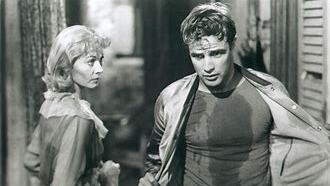
Elia Kazan
(APPROVED)
LGBTQ+ CHARACTER
*The Boy, Blanche’s late husband, a suicide.
LGBTQ+ ACTOR | SCREENWRITER | SOURCE MATERIAL
ACTOR: Marlon Brando
SCREENWRITER: Tennessee Williams
SOURCE MATERIAL: Tennessee Williams (adapted from his play “A Streetcar Named Desire”)
HOLLYWOOD’S BEST STAGE TO SCREEN ADAPTATION
TWO OF THE GREATEST PERFORMANCES IN MOVIE HISTORY
But I was unlucky. Deluded. There was something about the boy. A nervousness, a tenderness……an uncertainty. And I didn’t understand. I didn’t understand why this boy, who wrote poetry…..didn’t seem able to do anything else. He lost every job. He came to me for help. I didn’t know that. I didn’t know anything…..except that I loved him…..unendurably. At night I pretended to sleep. I heard him crying. Crying the way a lost child cries.
Blanche DuBois (VIVIEN LEIGH): “A Streetcar Named Desire”.
I killed him. One night…..we drove out to a place called Moon Lake Casino. We danced the Varsouviana. Suddenly, in the middle of the dance, the boy I married broke away from me…..and ran out of the casino. A few minutes later…..a shot. I ran. All did. All ran and gathered about the terrible thing at the edge of the lake. He’d stuck a revolver into his mouth…..and fired. It was because…..on the dance floor…..unable to stop myself, I’d said: “You’re weak. I’ve lost respect for you. I despise you.” And then…..the searchlight which had been turned on the world….was turned off again. And never…..for one moment since, has there been any light stronger than…Than this…..yellow lantern.
Blanche DuBois (VIVIEN LEIGH): “A Streetcar Named Desire”.
The performances of Marlon Brando and Vivien Leigh are two of the greatest in movie history.
NOW STREAMING ON AMAZON PRIME VIDEO, APPLE TV+, YOUTUBE
26. Strangers on a Train (1951)
A-
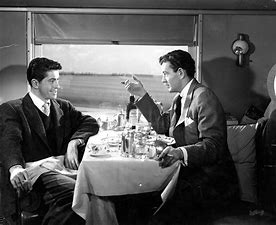
Alfred Hitchcock
(APPROVED)
LGBTQ+ CHARACTER
*Bruno Antony (Robert Walker)
LGBTQ+ ACTOR | SOURCE MATERIAL
ACTOR: Farley Granger
SOURCE MATERIAL: Patricia Highsmith (based on her novel “Strangers on a Train”)
HITCHCOCK TACKLES HIGHSMITH
Hitchcock reverses himself here, having gay actor Farley Granger play the straight character and straight actor Robert Walker play the gay character. Unfortunately, Granger’s character finds his happy ending in the arms of the not-so-great Ruth Roman, who, together with Anne Baxter (in “I Confess”), is known to be Hitchcock’s least favorite actress. Walker died, aged thirty-two, a few weeks after the film’s release.
Gay writer Patricia Highsmith also wrote five novels featuring the gay sociopath character Tom Ripley, which have seen numerous TV and movie adaptations, the most famous of which is “Purple Noon” (René Clément, 1960) – see below, movie number 44 – with Alain Delon, “The Talented Mr. Ripley” (Anthony Mingella, 1999) with Matt Damon and the eight-episode limited series on Netflix written and directed by Steve Zaillian, photographed in black-and-white by Robert Elswit and starring Andrew Scott.
Hitchcock’s cameos: “Strangers on a Train” is one of FIVE Hitchcock films in which he makes not one but TWO cameo appearances. The others are “The Lodger” (1927), “Suspicion” (1941), “Rope” (1948), and “Under Capricorn” (1949).
Cameo one: 0:02:22 He’s on the book’s cover that Farley Granger is reading.
Cameo two: 0:10:34 He’s seen boarding a train with a double bass as Farley Granger gets off in his hometown. The double bass is no accident since Hitchcock fills the movie with doubles and criss-crosses.
REMADE AS THROW MOMMA FROM A TRAIN BY DANNY DE VITO IN 1987
NOW STREAMING ON AMAZON PRIME VIDEO, APPLE TV+, YOUTUBE
27. Gentlemen Prefer Blondes (1953)
B+
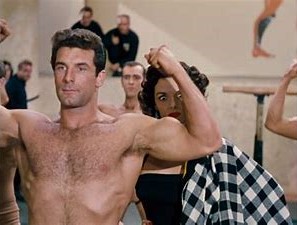
Howard Hawks
(APPROVED)
LGBTQ+ CHARACTERS
*The Boys in the Gym.
LGBTQ+ CHOREOGRAPHER | COSTUME DESIGNER
CHOREOGRAPHER: Jack Cole
COSTUME DESIGNER: William Travilla
Jane Russell cannot understand – but gives us the wink-wink that she does understand – why all the boys in the gym won’t give her a second look. It’s Howard Hawks again, this time adapting the Jule Stein/Leo Robin Broadway smash “Gentlemen Prefer Blondes,” Russell is singing “Ain’t There Anyone Here for Love.” At the same time, the boys only have eyes for themselves and their buddies. Meanwhile, Marilyn is more interested in a certain kind of rock, leading to an even more spectacular musical number called “Diamonds Are a Girl’s Best Friend,” Like “Gilda” and its famous musical numbers “Put the Blame on Mame” and “Amado Mio,” an essential ingredient in the magic of “Gentlemen Prefer Blonds” is Jack Cole’s choreography.
It was adapted from the play by Anita Loos and Joseph Fields and the Broadway musical by Stein and Robin.
NOW STREAMING ON AMAZON PRIME VIDEO, APPLE TV+, YOUTUBE
28. Calamity Jane (1953)
B
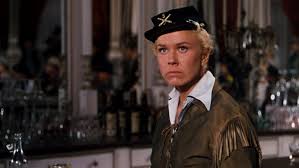
David Butler
(APPROVED)
LGBTQ+ CHARACTER
*Calamity Jane (Doris Day)
LGBTQ+ COSTUME DESIGNER
Howard Shoup
BEST QUEER SONG
“MY SECRET LOVE”
Doris Day was much more delightful in her tomboy Warner Bros. roles than she was playing all those professional virgins at Universal. And playing the famous Calamity Jane, she is at the apex of her Queerness. She has her hair cropped, she’s wearing buckskins, and she’s willing to draw a gun on anyone who makes fun of her. Although in love with military man Howard Keel, she doesn’t want to give up her gender-transgressing ways. Her inner conflict is finally announced to the Universe in one of the best uses of song in the history of Cinema: Day’s spectacular delivery of the Sammy Fain-Paul Francis Webster masterpiece “Secret Love,” a cri de coer that every gay person can relate to.
Original screenplay by James O’Hanlon. Directed by David Butler.
NOW SCREENING ON AMAZON PRIME VIDEO, APPLE TV, YOUTUBE
29. Johnny Guitar (1954)
B

Nicholas Ray
(APPROVED)
LGBTQ+ CHARACTERS
*Vienna (Joan Crawford)
*Emma Small (Mercedes McCambridge)
LGBTQ+ DIRECTOR
DIRECTOR: Nicholas Ray
A LESBIAN DUEL IN THE SUN!
On the outskirts of a wind-swept Arizona cattle town, an aggressive and strong-willed saloonkeeper named Vienna (Joan Crawford) maintains a volatile relationship with the local cattlemen and townsfolk. Not only does she support the railroad being laid nearby (the cattlemen oppose it), but she permits “The Dancin’ Kid” (her former lover) (Scott Brady) and his gang to frequent her saloon. The locals, led by John McIvers (Ward Bond) and egged on by Emma Small (Mercedes McCambridge), a one-time rival of Vienna for the Dancin’ Kid’s affections, are determined to force Vienna out of town. Vienna faces them down, helped by the mysterious and just-arrived Johnny Guitar (Sterling Hayden), a guitar player who had an interview scheduled with her that day. McIvers gives Vienna, Johnny Guitar, Dancin’ Kid, and his sidekicks 24 hours to leave. We know we are facing a showdown, but this one’s between Vienna and Emma, the first all-female duel in the history of the West!
The result is high camp on the range thanks to two of Hollywood’s most dramatic thespians. A Western with two female leads is the rarest of cinematic jewels. Although Crawford and McCambridge play to the gallery under Nicholas Ray’s mannered direction, this is essential viewing as part of Queer Cinema, the Western and the Ray canon.
“Johnny Guitar” was adapted from Roy Chanslor’s novel by Philip Yordan, who acted as a front for the poet, documentarist, and screenwriter Ben Maddow. Maddow had adapted “Intruder in the Dust” and “The Asphalt Jungle” (Oscar nomination) for MGM before finding himself persona non grata at the studios because of past left-wing affiliations.
A critical and commercial disappointment in America, the film was highly praised in Europe, most notably by then-French film critics Jean-Luc Godard and Francois Truffaut in the magazine Cahiers du Cinema. In his 1988 release “Women on the Verge of a Nervous Breakdown,” gay Spanish director Pedro Almodovar paid homage to “Johnny Guitar” in the scene in which his lead character Pepa (Carmen Maura), who is a voice artist, dubbs Joan Crawford’s Vienna in Spanish.
NOW STREAMING ON AMAZON PRIME VIDEO, APPLE TV+, YOUTUBE
30. Rebel Without a Cause (1955)
A
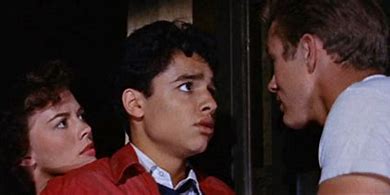
Nicholas Ray
(APPROVED)
LGBTQ+ CHARACTER
*Plato (Sal Mineo)
LGBTQ+ DIRECTOR | ACTORS |COSTUME DESIGNER
DIRECTOR: Nicholas Ray
ACTOR: James Dean
ACTOR: Sal Mineo
ACTOR: Nick Adams
COSTUME DESIGNER: Moss Mabry
SAL MINEO’S Plato is Hollywood’s first adolescent gay character.
ONE OF THE QUINTESSENTIAL LA MOVIES.
Natalie Wood, James Dean, and Sal Mineo form a nuclear family under the shadow of Griffith Park Observatory. Mineo’s Plato is Hollywood’s first adolescent gay character. The movie features Dean’s most emblematic performance under the soaring direction of Nicholas Ray. Jim Backus and Ann Doran are Dean’s parents, William Hopper is Wood’s father, and future Oscar nominees Dennis Hopper and Nick Adams are part of the gang at the infamous “Chicken Run.”
The stunning color cinematography is by the great Ernest Haller (“Gone with the Wind,” “Mildred Pierce,” “Whatever Happened to Baby Jane?”), and the original score is by Leonard Rosenman, who also scored Dean’s other 1955 movie, Elia Kazan’s “East of Eden”- he “invented” the Dean sound! The script, by Stuart Stern, was built around an original treatment by Irving Shulman and story concepts by Shulman and Ray. It is one of the quintessential LA movies.
NOW STREAMING ON AMAZON PRIME VIDEO, APPLE TV+, YOUTUBE
31. The Big Combo (1955)
B-
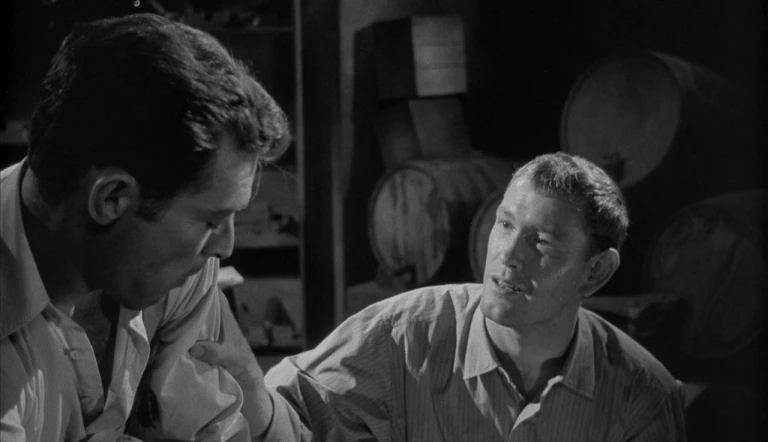
Joseph H. Lewis
(APPROVED)
LGBTQ+ CHARACTERS
*Fante (Lee Van Cleef)
*Mingo (Earl Holliman)
LGBTQ+ ACTOR
ACTOR: Earl Holliman
“The cops will be looking for us in every closet.”
Fante (LEE VAN CLEEF) to Mingo (EARL HOLLIMAN) in “The Big Combo”
THE SECOND GAY (MALE) COUPLE TO DECEIVE THE HAYS OFFICE
Fante and Mingo, played by Lee Van Cleef and Earl Holliman, are the henchmen for gangster Richard Conte. They are a gay couple. Everyone on screen seems to know it and respect their relationship. They sleep in the same bedroom, albeit in separate beds. How director Joseph Lewis managed to get by the Hays Office is a minor miracle. Their chosen profession adds to our fascination with them and adds to their sexiness. Arguably Lewis’ greatest movie and a film noir classic, it’s also worth watching for John Alton’s stunning black-and-white cinematography and the performances of Conte, Cornel Wilde, Jean Wallace, who was married to Wilde at the time, and Brian Donlevy. “The Big Combo” marked the final screen appearance of actress Helen Walker, who was so impressive opposite Tyrone Power in Edmund Golding’s “Nightmare Alley.” The memorable score is by David Raksin.
Original screenplay by Philip Yordan.
NOW STREAMING ON AMAZON PRIME VIDEO APPLE TV+, YOUTUBE
32. Written on the Wind (1956)
B+
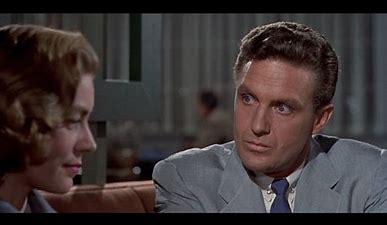
Douglas Sirk
(APPROVED)
LGBTQ+ CHARACTER
*Kyle Hadley (Robert Stack)
LGBTQ+ ACTOR | COSTUME DESIGNER
ACTOR: Rock Hudson
COSTUME DESIGNER: Bill Thomas
ROBERT STACK’S KYLE HADLEY IS A GAY MAN WITH A LOW SPERM COUNT!
In director Douglas Sirk’s Southern Gothic melodrama, Robert Stack’s Kyle Hadley, the alcoholic heir of a Texas oil dynasty, has deeper feelings for his childhood friend Mitch (Rock Hudson) than for his lovely new wife (Lauren Bacall). Drenched in magnificent technicolor courtesy of cinematographer Russell Metty, the film’s central tenet is that Kyle and his ruthless sister Marylee (Oscar winner Dorothy Malone) lust after the same man. Kyle has the added misfortune of having a low sperm count.
Robert Stack received his only Oscar nomination for this role.
Adapted from the novel by Robert Wilder (brother of director William Wyler).
Now streaming on AMAZON PRIME VIDEO
33. The Bad Seed (1956)
B+
Nature brought her here, and nature took her away!
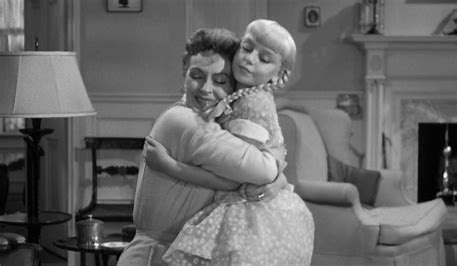
Mervyn LeRoy
(APPROVED)
LGBTQ+ CHARACTER
*Little Claude Daigle is killed off-camera as the film begins.
LGBTQ+ COSTUME DESIGNER
Moss Mabry
Director Mervyn LeRoy’s High Wire Act
When Mervyn LeRoy first saw Maxwell Anderson’s play “The Bad Seed,” he instructed screenwriter John Lee Mahin to adapt it with minimal changes. Meanwhile, he went to work on toning down the performances. The central character is Rhoda Penmark, a little girl in pinafore dresses and blonde pigtails who embodies evil.
LeRoy brought most of the cast from the stage to the screen intact: Nancy Kelly (Oscar Nomination for Best Actress) as Christine Penmark, Rhoda’s mother; Patty McCormack (Oscar nomination for Best Supporting Actress) as Rhoda, the progeny from hell who kills her classmate Little Claude Daigle because he won the penmanship medal she felt she deserved – we later discover that Rhoda is a sociopath and a serial killer just like her grandmother, but the expression of the “bad seed” gene ended up skipping a generation; William Hopper as Col. Kenneth Penmark, Rhoda’s father who is away on business for most of the movie; Eileen Heckart (Oscar nomination for Best Supporting Actress) as Hortense Daigle, Claude’s mother; Frank Cady as Henry Daigle, Claude’s father; Henry Jones as Leroy Jessop, the caretaker; Evelyn Varden as Monica Breedlove, the neighbor who spoils Rhoda; and Paul Fix as Christine’s father and Rhoda’s Grandfather.
In many ways, “The Bad Seed” is the gay movie experience. Running cartwheels around all the definitions of camp outlined by Ms. Susan Sontag in her famous essay, this theatrical classic is a highwire act for both the director and his actors. Nancy Kelly is ON 100% of the time, straddling the twin minefields of camp and drama yet managing to accomplish both simultaneously. Her work here influenced the performances in such genre classics as Robert Aldrich’s “Whatever Happened to Baby Jane” and Brian De Palma’s “Carrie.”
How do we know that Little Claude Daigle was gay?
- He won a medal for best penmanship.
- He let a girl beat him up.
- He let a girl beat him up a second time.
Then there is Miss Patty McCormack’s sweet-as-pie eight-year-old killer whose bratty pronouncements such as “Give me those shoes, they’re mine” have entered the gay lexicon.
Then there are the two performances which work as straight drama: a heartbreaking Eileen Heckart, playing both of her big scenes drunk, as the dead boy’s mother and a beautiful turn by Henry Jones as the simple caretaker who knows Rhoda’s secret and pays dearly for his knowledge. Jones’s character was later taken, fully formed, and transported to Seattle for Ernie Hudson in “The Hand that Rocks the Cradle.”
NOW STREAMING ON AMAZON PRIME VIDEO, APPLE TV+, YOUTUBE
34. Tea and Sympathy (1956)
A-
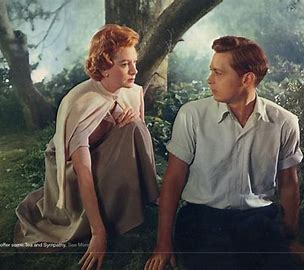
Vincente Minnelli
(APPROVED)
LGBTQ+ CHARACTER
*Tom Robertson Lee (John Kerr)
*Bill Reynolds (Leif Erickson)
LGBTQ+ DIRECTOR
Vincente Minnelli
“One day, when you talk about this, and you will, be kind.”
Laura Reynolds (DEBORAH KErR) IN “Tea and Symphony”.
Both John Kerr and Deborah Kerr reprised their roles on the Broadway Stage.
The consensus today is that even if Deborah’s character Laura Reynolds, the mistress of a household of college boys, manages to “save” Tom Robertson Lee’ (John Kerr) from his sensitive (read homosexual) tendencies by seducing him, she cannot save herself from the fact that she married a gay man (Leif Erickson) and is trapped in a loveless union. Bill has taken the opposite road to Tom. He is hyper-masculine, preferring the company of men to women.
In many ways, the film has improved with age. What could not be said under the Hayes code (according to Deborah, the words homosexual, gay, or queer were never mentioned during the entire production – not even, or especially, by gay director Vincente Minnelli) gives it a beauty and delicacy, especially in Deborah’s sublime performance.
Adapted from the play by Robert Anderson.
NOW STREAMING ON AMAZON PRIME VIDEO, APPLE TV+, YOUTUBE
PLEASE CONTINUE TO PART TWO
https://thebrownees.net/essay-one-2-31-queer-films-made-under-the-hays-code-1957-1967/
PLEASE CONTINUE TO TABLE
https://thebrownees.net/essay-one-table-65-queer-films-made-under-the-hays-code-1934-1937/
https://thebrownees.net/essay-one-1-2-65-queer-films-under-the-hays-code-1934-1967/
Essay Two. 50 Queer Films from 1967-1976: Queer Cinema Comes Out. – TheBrownees
Essay Two. Table. 50 Queer Films from 1967-1976: Queer Cinema Comes Out. – TheBrownees


















